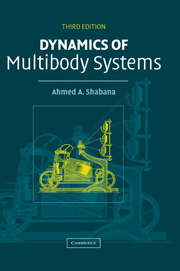5 - FLOATING FRAME OF REFERENCE FORMULATION
Published online by Cambridge University Press: 10 November 2009
Summary
In this chapter, approximation methods are used to formulate a finite set of dynamic equations of motion of multibody systems that contain interconnected deformable bodies. As shown in Chapter 3, the dynamic equations of motion of the rigid bodies in the multibody system can be defined in terms of the mass of the body, the inertia tensor, and the generalized forces acting on the body. On the other hand, the dynamic formulation of the system equations of motion of linear structural systems requires the definition of the system mass and stiffness matrices as well as the vector of generalized forces. In this chapter, the dynamic formulation of the equations of motion of deformable bodies that undergo large translational and rotational displacements are developed using the floating frame of reference formulation. It will be shown that the equations of motion of such systems can be written in terms of a set of inertia shape integrals in addition to the mass of the body, the inertia tensor, and the generalized forces that appear in the dynamic formulation of rigid body system equations of motion and the mass and stiffness matrices and the vector of generalized forces that appear in the dynamic equations of linear structural systems. These inertia shape integrals that depend on the assumed displacement field appear in the nonlinear terms that represent the inertia coupling between the reference motion and the elastic deformation of the body. It will be also shown that the deformable body inertia tensor depends on the elastic deformation of the body, and accordingly it is an implicit function of time.
Information
- Type
- Chapter
- Information
- Dynamics of Multibody Systems , pp. 188 - 266Publisher: Cambridge University PressPrint publication year: 2005
Accessibility standard: Unknown
Why this information is here
This section outlines the accessibility features of this content - including support for screen readers, full keyboard navigation and high-contrast display options. This may not be relevant for you.Accessibility Information
- 1
- Cited by
